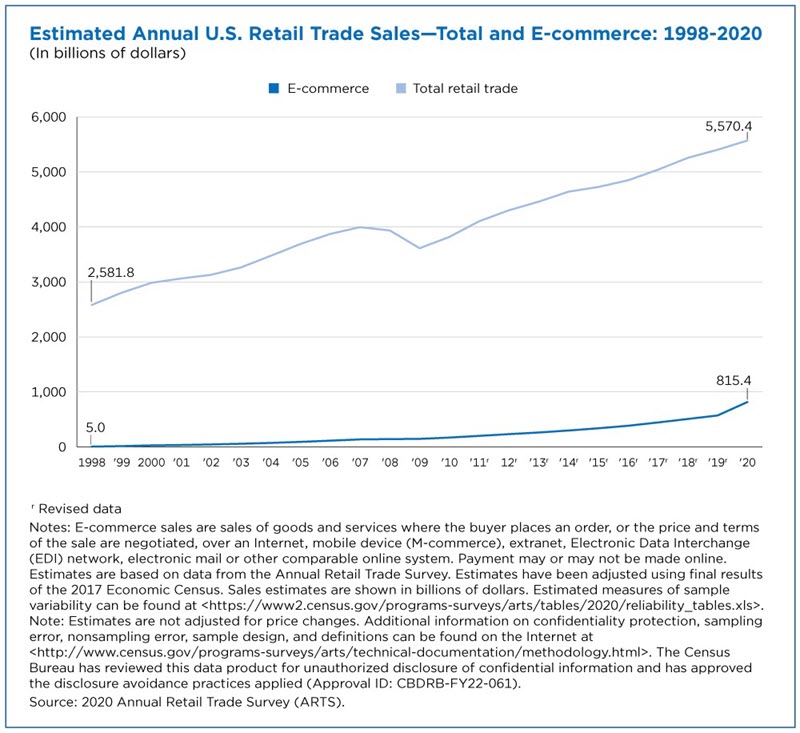Annual Retail Trade Survey Shows Impact of Online Shopping on Retail Sales During COVID-19 Pandemic
Has the pandemic changed the way you shop? Do you now routinely have your groceries delivered or opt for curbside pickup?
You’re not alone. Consumer behaviors have changed in many ways since the COVID-19 pandemic hit. More began working from home and avoiding indoor venues, including shopping malls and restaurants.
Because of these consumer behavior changes, e-commerce has continued to grow and many brands have been pivoting their business strategies to remain competitive.
While retail e-commerce grew, sales in some industries declined from 2019 to 2020 as pandemic-related lockdowns kept people at home, working, shopping and even studying online.
E-Commerce Boom
The Census Bureau’s Annual Retail Trade Survey (ARTS) first released data in 1952 and now produces national estimates of total annual sales, e-commerce sales, sales taxes, end-of-year inventories, purchases, total operating expenses, per capita sales, and gross margins of U.S. retail businesses.
Seven decades of data provide a window into historical retail trends. For example, ARTS first collected data on e-commerce in 1998, when online sales were just $5.0 billion and online retail was just emerging as an irreversible force. More than 20 years later, e-commerce sales top $800 billion.
According to the most recent 2020 ARTS release, e-commerce sales increased by $244.2 billion or 43% in 2020, the first year of the pandemic, rising from $571.2 billion in 2019 to $815.4 billion in 2020.
How Some Industries Fared
While retail e-commerce grew, sales in some industries declined from 2019 to 2020 as pandemic-related lockdowns kept people at home, working, shopping and even studying online.
Here’s how some U.S. retail sectors fared in this virtual world:
- Sales at gasoline stations fell from $513.5 billion in 2019 to $428.1 billion in 2020, as commuting became unnecessary for many and travel slowed down.
- Sales at bookstores dropped from $8.9 billion in 2019 to $6.2 billion in 2020.
- Sales at clothing and clothing accessories stores slipped from $269.5 billion in 2019 to $201.4 billion in 2020, as the need for new clothes and accessories for the workplace or social outings waned.
Retail Evolution
In the face of changes partly caused by the pandemic, retailers are finding new ways to capitalize on the convenience economy of online shopping and at-home delivery.
Some brick-and-mortar stores have tried to enhance the shopping experience to give consumers a reason to leave their online comfort zone and return to in-store shopping.
For example, some retailers have held in-store parties decked out with DJs, refreshments and door prizes. Others now accept in-store returns of online purchases to lure customers to their stores.
Census Bureau resources and tools can help businesses make data-driven decisions. This recent podcast, Hidden Gems of Economic Surveys, specifically discusses ARTS and provides more comprehensive information.
Related Statistics
Stats for Stories
Stats for Stories
Facts for Features & Special Editions
Subscribe
Our email newsletter is sent out on the day we publish a story. Get an alert directly in your inbox to read, share and blog about our newest stories.
Contact our Public Information Office for media inquiries or interviews.







